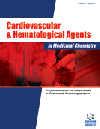- Home
- A-Z Publications
- Cardiovascular & Hematological Agents in Medicinal Chemistry (Formerly Current Medicinal Chemistry - Cardiovascular & Hematological Agents)
- Previous Issues
- Volume 5, Issue 3, 2007
Cardiovascular & Hematological Agents in Medicinal Chemistry (Formerly Current Medicinal Chemistry - Cardiovascular & Hematological Agents) - Volume 5, Issue 3, 2007
Volume 5, Issue 3, 2007
-
-
Advances in Antithrombotic Agents
More LessAuthors: Ranjan Chakrabarti and Saibal Kumar DasThrombosis is the condition where an imbalance in the homeostatic mechanism results in unwanted intravascular thrombus formation. Imbalances in this highly regulated process of coagulation and anticoagulation can lead to a variety of pathophysiological conditions leading to stroke, pulmonary heart attack and other serious conditions. In the western world, thromboembolic diseases are the leading cause of morbidity Read More
-
-
-
Carbohydrates in Therapeutics
More LessAuthors: Michelle Kilcoyne and Lokesh JoshiAwareness of the importance of carbohydrates in living systems and medicine is growing due to the increasing understanding of their biological and pharmacological relevance. Carbohydrates are ubiquitous and perform a wide array of biological roles. Carbohydrate-based or -modified therapeutics are used extensively in cardiovascular and hematological treatments ranging from inflammatory diseases and anti-thromb Read More
-
-
-
JAK2 as a Molecular Marker in Myeloproliferative Diseases
More LessAuthors: R. Mata, D. Subira, A. Garcia-Raso and P. LlamasThe molecular pathogenesis of the myeloproliferative disorders (MPD) is poorly understood, except for chronic myeloid leukemia (CML). Recently, several groups have discovered a novel recurrent unique acquired clonal mutation in a tyrosine-kinase JAK2 in patients with Philadelphia-negative MPD and other myeloid disorders. It consists in a guanineto- thymine change encoding a valine to phenylalanine at codon 617 (JAK2 V61 Read More
-
-
-
Development of Nitric Oxide Donors for the Treatment of Cardiovascular Diseases
More LessAuthors: Hidemasa Katsumi, Makiya Nishikawa and Mitsuru HashidaNitric oxide (NO) is a molecule that dynamically modulates the physiological functions of the cardiovascular system, which include relaxation of vascular smooth muscle, inhibition of platelet aggregation, and regulation of immune responses. Because a reduced NO level has been implicated in the onset and progression of various disease states, NO is expected to provide therapeutic benefits in the treatment of cardiovascular Read More
-
-
-
Management of Cardiovascular Risk Factors in Patients with Metabolic Syndrome
More LessAuthors: Alejandro de la Sierra and Luis Miguel RuilopeMetabolic syndrome is defined as the combination of abdominal obesity, insulin resistance, atherogenic dyslipidemia, and prothrombotic and proinflammatory states. Due to the epidemic proportion of overweight and obesity worldwide and the development of useful clinical tools to identify these patients more easily, metabolic syndrome is increasingly recognized in adults and represents a clear risk factor for the developme Read More
-
-
-
Statins and Metabolism of High Density Lipoprotein
More LessAuthors: Dmitri Sviridov, Paul Nestel and Gerald WattsStatins are competitive inhibitors of HMG-CoA reductase, the rate-limiting enzyme of cholesterol biosynthesis. Statins are widely and successfully used for lowering plasma cholesterol levels causing up to 45% reduction of plasma cholesterol and considerable reduction in risk of cardiovascular diseases. The main atheroprotective action of statins is reduction of plasma low density lipoprotein levels due to improved clearance of t Read More
-
-
-
Natural Products to Anti-trypanosomal Drugs: An Overview of New Drug Prototypes for American Trypanosomiasis
More LessAuthors: Andre Gustavo Tempone, Patricia Sartorelli, Charles Mady and Fabio FernandesProtozoan tropical diseases cause great suffering throughout developing countries, with high rates of morbidity and mortality. American Trypanosomiasis affects 16-18 million people in Latin America, representing a dramatic disease among symptomatic patients. Old, toxic and ineffective chemotherapeutic agents continue to be used for the treatment of Chagas' disease. Since the early days of medicine, chemi Read More
-
-
-
Advanced Glycation End Products (AGEs) and Cardiovascular Disease (CVD) in Diabetes
More LessAuthors: Sho-Ichi Yamagishi, Takanori Matsui, Shin-Ichiro Ueda, Kazuo Nakamura and Tsutomu ImaizumiAccelerated atherosclerosis and microvascular complications are perhaps the leading cause of coronary heart disease, blindness and renal failure, which could account for disabilities and high mortality rates in patients with diabetes. Several mechanisms including endothelial cell damage, platelet activation and aggregation, hypercoagulability, and impaired fibrinolysis are involved in the pathogenesis of thrombogenic diath Read More
-
-
-
Regulation of Blood Pressure by D5 Dopamine Receptors
More LessAuthors: Chunyu Zeng, Zhiwei Yang, Laureano D. Asico and Pedro A. JoseDopamine receptors have been identified in a number of organs and tissues, which include the central and peripheral nervous systems, various vascular beds, the heart, the gastrointestinal tract, and the kidney. Dopamine receptors are classified into D1- and D2-like subtypes based on their structure and pharmacology; during conditions of moderate sodium balance, more than 50% of renal sodium excretion is regulated by Read More
-
Volumes & issues
-
Volume 23 (2025)
-
Volume 22 (2024)
-
Volume 21 (2023)
-
Volume 20 (2022)
-
Volume 19 (2021)
-
Volume 18 (2020)
-
Volume 2 (2020)
-
Volume 17 (2019)
-
Volume 16 (2018)
-
Volume 15 (2017)
-
Volume 14 (2016)
-
Volume 13 (2015)
-
Volume 12 (2014)
-
Volume 11 (2013)
-
Volume 10 (2012)
-
Volume 9 (2011)
-
Volume 8 (2010)
-
Volume 7 (2009)
-
Volume 6 (2008)
-
Volume 5 (2007)
-
Volume 4 (2006)
Most Read This Month
Article
content/journals/chamc
Journal
10
5
false
en


